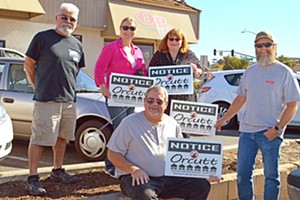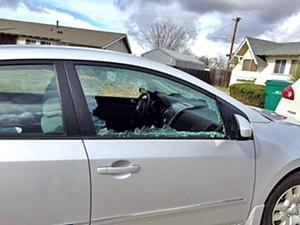One morning in June 2015, Debbie O’Campo awoke to an unpleasant surprise: All of the tires on her 2013 GMC Terrain Denali were gone.
She was notified by a stranger’s knock on the door of her Orcutt home shortly before she started her day as the plant services coordinator at Allan Hancock College.
It was apparently the work of thieves. They left the passenger side of her SUV on scissor jacks but dumped the driver’s side onto the street, embedding the rotors into the asphalt, and causing more than $10,000 worth of damage.
“What they tried doing is remove the jacks from the passenger side but they couldn’t,” O’Campo told the Sun. “The jacks were embedded into the asphalt too.”

The thieves haven’t been caught, O’Campo said, but it’s only a small sample of the crimes that have been occurring in Orcutt during the past year that are getting on the nerves of its residents.
In recent weeks a series of thefts have left Orcutt residents riled, including: a Santa Barbara County Sheriff’s Office report that on Jan. 21 someone ransacked the storage unit and snack shed of the Orcutt Youth Softball Association, stealing more than $15,000 worth of equipment; another Sheriff’s Office report of a string of auto burglaries in December; and frequent package thefts from front porches in the same month preceding the Christmas holiday.
The thefts may not be as serious as the recent homicides in Santa Maria, but the close proximity to the city means, in some residents’ minds, that Santa Maria’s crime problems could soon become Orcutt’s if ignored. Some say the minimal staffing of the North County sheriff’s substation nearby is exacerbating these concerns.
A handful of fed-up citizens started Orcutt Neighborhood Watch as a Facebook group more than five months ago to unite residents in protecting the quality of life in their sleepy, unincorporated community of roughly 30,000.
As it turns out, social media is an effective tool for crime fighting. But, as some of the group’s administrators are also finding out, information is hard to control in the light-speed flow of the Internet. Now the group is moving beyond a digital world and finding organization in real space.
Neighborhood watch party
It’s was a the evening of Saturday, Jan. 9, at Giavanni’s Pizza in Orcutt and there was a private party being held in the back room of the restaurant when random people began piling in through the rear entrance.
Sitting among the multicolored balloons and the hustle and bustle of wait staff were 50 to 60, perhaps more, concerned residents with worried looks on their faces. It was the first unofficial meeting of the Orcutt Neighborhood Watch (ONW).
It was a big turnout—much bigger than anyone expected. The discussion shifted from topics that ranged from Megan’s Law to smartphone apps. One person suggested an ONW official website. Someone suggested the use of Nextdoor, a social networking mobile app for neighborhood watches in the U.S.
This was the first attempt at organizing outside Facebook.
“What we’re trying to do is impose a little bit of structure and organization so it can better meet the needs of the neighborhoods,” said administrator Teri White, a financial advisor in Orcutt with some experience working in law enforcement.
Aside from the obvious function of deterring crime, White said ONW was formed as a way for Orcutt residents to share information, get to know each other, and “build a stronger community.” But with the group exploding to more than 3,300 members, it’s hard to keep track of who’s who, or what’s being posted.
Whether it’s the case that petty crimes are rising or that people are simply becoming more aware of what always existed, the Facebook group is constantly buzzing with reported observations.
White said this could be good or bad—good because it’s creating heightened awareness, and bad because the information is not always interpreted well.
While White generally encourages sharing information in the group, there are ground rules: no name calling, no soliciting, no fights, don’t be rude, share information in a neutral manner, and don’t share anything that isn’t useful. Seems easy to follow, but things can quickly spiral out of control, fueling paranoia and anxiety.
In one case, a report posted to the ONW Facebook page in early January sparked outrage from members within the group.
Details are vague but the basic outline goes something like this: Someone noticed a suspicious person in their neighborhood and called the police. After being questioned, it turned out that the person was a teenager who was weeks away from entering active military service. Drawing ire from several members within a short period of time, the Facebook thread had to be deleted.
“We’re not trying to be a drama site,” White said. “We’re trying to be an information site.”
While some people may see this as an affront to civil liberties, White wouldn’t be offended if it were her, she said.
“Stopping people to ask who they are? I don’t really see that as a problem,” White said. “If they were arresting people without cause, then that’s something else.”
She said it’s probably a helpful thing for citizens to take a proactive stance if it means keeping the community safe. That vigilance is also a necessary precaution for a growing unincorporated area big enough to be its own city, but without a police force like an official city would have.
A broken window of opportunity?
According to Al Avila, chair of the applied behavior sciences department at Hancock College, the Broken Windows Theory is the idea that unchecked petty crimes will eventually lead to more serious crimes.
It’s a theory first put forth by academics George R. Kelling and James Q. Wilson in 1982 and comes from the idea that broken windows on an abandoned building will encourage ever-increasing levels of vandalism and crime upon the building.

Avila said this idea applies to any type of small crime, like graffiti vandalism. If it’s removed immediately, Avila said, the idea is that the tagger will become discouraged and give up.
“When things look like they’re unkempt, it gives the appearance that people aren’t really looking out for the neighborhood,” Avila said. “It builds an idea that this is a community that people don’t really care about, and it can lead to other problems that are bigger.”
If nuisance crimes aren’t enough to galvanize a community into action, Avila said a crime that shocks the conscience most likely will.
Such was the case of the rape and murder of Catherine Genovese in Queens, N.Y., in 1964. According to the The New York Times, Genovese’s murder became a “symbol of public apathy” from which eventually sprouted the beginnings of the modern neighborhood watch programs.
According to the National Sheriff’s Association website, the association organized one of the first citizen neighborhood watch programs called USAonWatch in 1972 and it’s still active today as the National Neighborhood Watch. Groups are encouraged to register at nnw.org.
A well-organized group can be effective, Avila said, although sometimes it can lead to a vigilante-type mentality in some people.
Avila points to the case of Trayvon Martin, the unarmed 17-year-old African-American male shot and killed on Feb. 26, 2012, in a gated Florida community by George Zimmerman, a resident who was reportedly acting under the auspices of a neighborhood watch program.
“If hysteria starts to kick in, sometimes the response can make those types of situations more than what they are,” Avila said.
He added that sometimes watch groups form in the absence of law enforcement protection, particularly in the face of shrinking police departments.
Bone crew
Santa Barbara County Sheriff’s Office Deputy John Fleming began his shift around 6 p.m. on Jan. 31. It was a Saturday night. After a 30-minute briefing, he hung out in the patrol room and waited for a colleague to finish taking a phone call before he and a crew of three other deputies began their patrols.
Fleming works 80 hours every two weeks, working three 12-hour days in one week, and three 12-hour shifts and an eight-hour shift the second week, with the option of tacking an extra four hours onto his eight-hour shift if necessary, which is most often the case, according to Sheriff’s Office representatives. He’s one of eight deputies in addition to four senior deputies and four sergeants who are assigned to the Santa Maria substation just off of Foster Road—which is at minimum staffing—and patrol a roughly 800-square-mile area between Cuyama and Lompoc.
Two deputies, a senior deputy, and a sergeant is considered minimum staffing and on duty at any given time, along with a full-time school resource deputy at Righetti and Delta high schools, and a full-time rural crime deputy. A K-9 deputy works the night shift Thursday through Saturday.
Even so, the Santa Barbara County Sheriff’s Office is down 58 positions since 2007 as a result of the last recession, according to Sheriff’s Office Public Information Officer Kelly Hoover. In addition to those unfunded positions, the Sheriff’s Office currently has 41 funded vacancies, of which 10 are sworn deputy positions, although that number varies depending on retirements and new hires, Hoover said.
It’s a balancing act. Lt. Brian Olmstead, commander of the Santa Maria substation, said that in addition to being generally short staffed, there are also officers who get sick or injured, or take vacation time.
“Anyone who wants to take vacation or calls in sick, we have to call someone in for overtime,” Olmstead told the Sun.
It’s also harder to hire police officers these days, Olmstead said, attributing that to waning interest in law enforcement and the fact that many recruits don’t pass background checks. The turnaround time for a new recruit is not a quick process. For the officers who make the cut, training a patrol deputy for the field takes about 18 months.
Then there are challenges when it comes to officers actually doing their jobs. Olmstead cited Proposition 47 and AB 109 as challenges faced by officers when keeping criminals off the streets. The proposition reduces certain types of felonies to misdemeanors. Passed by voters in 2014, it’s an attempt to reduce prison and jail populations in California.
Without a promise of jail time, the law could encourage repeat offenders. Olmstead told the Sun that he’s seen an increase of bench warrants from offenders who were cited for alleged crimes that would’ve normally called for an arrest.
Olmstead emphasized that the Orcutt area is still quite safe and that ONW is generally a good idea because it gets people to communicate with each other. But he warned about passing along false information.
“What we’ve seen is that false info gets put out there—like a vehicle description—and it just sort of repeats itself,” Olmstead said.
Many of the auto theft crimes can be prevented by simply locking doors and removing valuable items, Olmstead added.
Crime statistics provided to the Sun by the Sheriff’s Office indicate that some crimes, such as theft, have declined or steadied since 2011 while others, such as vandalism, have steadily crept up. Stats from 2015 are still preliminary.
Hoover added that even with the short staffing, the Sheriff’s Office receives mutual aid from nearby agencies when needed, including the Santa Maria and Guadalupe police departments, California Highway Patrol, and even the FBI.
Assimilation
Nowadays, there is virtually no geographic distinction between Orcutt and Santa Maria. Occasionally dubbed the “suburbs of Santa Maria,” could the city reasonably accommodate Orcutt for the purposes of police protection?

Most likely not, according to Santa Maria City Manager Rick Haydon, who said there have been discussions in the past. However, he said that the city has no interest because Orcutt does not have a big enough tax base.
While Orcutt may be enjoying some growth in terms of residential properties, Haydon said there is no significant sales-tax base there, and Orcutt couldn’t afford the same ratio of officers Santa Maria provides its city. When it comes to annexation, Haydon gave a little perspective of what needs to be considered.
According to Haydon, there are 1.25 officers per 1,000 people in Santa Maria. If Orcutt were to be annexed—essentially assimilated—into Santa Maria, the city would need somewhere in the ballpark of 38 more police officers. With a salary in between $120,000 and $150,000 in total salary and benefits, that means
$4.5 million would be needed to pay them.
Tack on a fire station with nine employees, and the total cost of the extra fire and police officers goes up to $7 million, Haydon said. That figure doesn’t include costs for their equipment and operational expenses.
Haydon said that Orcutt would need a combined property and sales-tax base in the billions in order to pay for the increased services, because the city itself only receives a fraction of sales tax—about 10 percent.
“People are shocked when they find out only 10 percent goes back to the city,” Haydon said. “That’s why it’s so difficult to enhance city services. We can’t just hire employees for hiring’s sake.”
Going forward
The ONW is already starting to see results. People are noticing more frequent patrols at night. On Jan. 16, sheriff’s deputies arrested two suspects, 27-year-old Ray Dulany and 36-year-old Jesse Medina, whom detectives have linked to recent car burglaries in Orcutt.
More collaboration between the police and ONW could be happening soon. Hoover said the Sheriff’s Office is researching the use of the Nextdoor app as well.
There’s a meeting in the works for the ONW later this month, although White wants to keep it a tight meeting with no more than a dozen or so people. There, she said, they’ll attempt to assign block captains.
“It is probably a helpful thing to take a proactive stance to work together to keep the environment as safe as they can,” White said. “To that end, maybe Santa Maria would want to do the same thing.”
Staff Writer David Minsky can be reached at [email protected].










